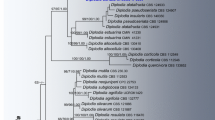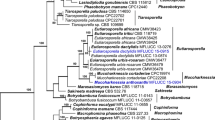Abstract
The chemical variation inLecanora epibryon andL. subimmersa, two species of theL. subfusca group, has been examined. In both species the chemical differences are correlated with geographical distribution, but not with morphological differences. As a consequence the chemotypes are recognized at subspecific level. InL. epibryon three chemical races are segregated according to the various chemosyndromes present. Subspeciesepibryon, containing atranorin and triterpenoids, occurs in the northern hemisphere and South America, while the other two subspecies occur only in the southern hemisphere. The subsp.broccha (Nyl.)Lumbsch, comb. nova, contains atranorin, the stictic acid and the 2,5,7-trichloro-3-O-methylnorlichexanthone chemosyndromes, while subsp.xanthophora Lumbsch, subsp. nova, is similar but lacks the stictic acid chemosyndrome. Two chemical races occur in the pantropical speciesL. subimmersa. While subsp.subimmersa contains atranorin and zeorin, subsp.ramboldii Lumbsch & Elix, subsp. nova, contains an additional ten chlorinated xanthones.L. impressa is reduced to synonymy toL. subimmersa.
Similar content being viewed by others
References
Brodo, I. M., 1984: The North American species of theLecanora subfusca group. — Beih. Nova Hedwigia79: 63–185.
Culberson, C. F., 1972: Improved conditions and new data for the identification of lichen products by a standardized thin-layer chromatographic method. — J. Chromatogr.72: 113–125.
, 1982: Substitution of methyl tert.-butyl ether for diethyl ether in standardized thin-layer chromatographic method for lichen products. — J. Chromatogr.238: 438–487.
, 1981: A standardized TLC analysis of β-orcinol depsidones. — Bryologist84: 16–29.
Culberson, W. L., 1969: The use of chemistry in the systematics of the lichens. — Taxon18: 152–166.
, 1986: Chemistry and sibling speciation in the lichen-forming fungi: ecological and biological considerations. — Bryologist89: 123–131.
Egan, R. S., 1986: Correlations and non-correlations of chemical variation patterns with lichen morphology and geography. — Bryologist89: 99–110.
Elix, J. A., Jenkins, G. A., Lumbsch, H. T., 1989: Chemical variation in the lichenLecanora epibryon s. ampl. (Lecanoraceae: Ascomycotina). — Mycotaxon35: 169–175.
Esslinger, T. L., 1977: A chemosystematic revision of the brownParmeliae. — J. Hattori Bot. Lab.42: 1–211.
, 1989: Systematics ofOropogon (Alectoriaceae) in the New World. — Syst. Bot. Monogr.28: 1–111.
Feige, G. B., Lumbsch, H. T., Huneck, S., Elix, J. A., 1993: The identification of lichen products by a standardized high-performance liquid chromatographic method. — J. Chromatogr.646: 417–427.
Galloway, D. J., 1985: Flora of New Zealand lichens. — Wellington: Hasselberg.
Hawksworth, D. L., 1976: Lichen chemotaxonomy. — InBrown, D. H., Hawksworth, D. L., Bailey, H., (Eds): Lichenology: progress and problems, pp. 139–184. — London: Academic Press.
Imshaug, H. A., Brodo, I. M., 1966: Biosystematic studies onLecanora pallida and some related lichens in the Americas. — Nova Hedwigia12: 1–59.
Leuckert, C., Poelt, J., 1989: Studien über dieLecanora rupicola-Gruppe in Europa (Lecanoraceae). — Nova Hedwigia49: 121–167.
Lumbsch, H. T., 1994: DieLecanora-subfusca-Gruppe in Australasien. — J. Hattori Bot. Lab. (in press).
Paus, S., Daniels, F. J. A., Lumbsch, H. T., 1993: Chemical and ecological studies in theCladonia subulata complex in Northern Germany (Cladoniaceae, lichenisedAscomycotina). — Bibl. Lichenol.53: 191–200.
Rambold, G., 1989: A monograph of the saxicolous lecideoid lichens in Australia (Excl. Tasmania). — Bibl. Lichenol.34: 1–345.
Rogers, R. W., 1989: Chemical variation and the species concept in lichenizedAscomycetes. — Bot. J. Linn. Soc.101: 229–239.
Author information
Authors and Affiliations
Rights and permissions
About this article
Cite this article
Lumbsch, H.T., Feige, G.B. & Elix, J.A. Chemical variation in two species of theLecanora subfusca group (Lecanoraceae, lichenizedAscomycotina). Pl Syst Evol 191, 227–236 (1994). https://doi.org/10.1007/BF00984667
Received:
Revised:
Accepted:
Issue Date:
DOI: https://doi.org/10.1007/BF00984667




